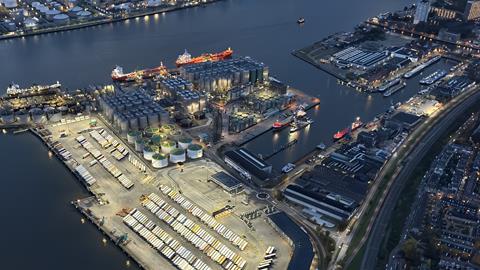Tank storage company Vopak has recently installed an e-boiler at its terminal in Vlaardingen. This could reduce gas consumption by a third. ‘The benefits lie in sustainability and CO2 reduction.’
Electrification is seen as one of the most important ways for industry to become more sustainable. According to the Dutch government’s Electrification Roadmap, at least 30 TWh of additional electricity will be needed by 2030 to further electrify industry. The document also calculates that industrial energy demand will rise to 80-130 TWh by 2050, of which 60% will come from electrification.
But the Netherlands is struggling with grid congestion: the current electricity grids are not equipped to handle the growing demand and the typical intermittent nature of renewable electricity supply. Looking at Netbeheer Nederland’s capacity map, two-thirds of the Netherlands is coloured red, which means ‘transport capacity shortage with queue’. In some places, the queue for electrification projects has grown to ten to fifteen years.
Heated fats
Nevertheless, new electrification projects by industrial companies regularly make the news. Tank storage company Vopak, for example, recently announced that it had installed a new electric boiler at its terminal in Vlaardingen. The reason the tank storage company’s project is not on the waiting list is that the application and installation for a heavier connection has already been made in 2020, says site manager Geert Dijkshoorn.
At the Vlaardingen terminal, Vopak has 310 tanks with a total capacity of more than 600,000 m3 for storing edible vegetable oils and animal fats, oleochemicals and biodiesel, among other products. Some of these products require heating to keep them in their liquid state during storage. Dijkshoorn: ‘We heat our tanks with steam at about 160 degrees Celsius and 10 bar. This is a temperature that can be achieved with an electric boiler.’
‘When the supply of sustainable energy is high, we buy electricity and use our electric boiler. On cold days, we need more heat and the gas boiler can help.’
Geert Dijkshoorn
According to Dijkshoorn, using geothermal heat or residual heat from a heating network is not worthwhile. ‘Geothermal heat usually has a temperature of only 40 to 50 degrees Celsius. And the heat from heating networks is around 75 degrees Celsius. That means we would have to upgrade it. It would be more efficient to do this with the steam we generate, which has given off its heat, and send it back to the boiler house. It would then have cooled down to about 80-90 degrees and we could use it again in the electric boiler.’
The gas boilers will remain in use at Vopak. Dijkshoorn: ‘When the supply of sustainable energy is high, we use electricity and our e-boiler. When the availability of green energy is lower, we automatically switch to the existing gas boilers. On cold days we need more heat and the gas boiler can help.’ In this way, Vopak uses green electricity and reduces the load on the grid when there is strong wind and/or bright sunshine.
Cost-neutral
The e-boiler has a capacity of 10 MW and requires a substantial investment of more than €5 million. Dijkshoorn: ‘The e-boiler operates at a voltage of 10 kV. The cables, connections and installations are expensive. But the cost of electricity is also high. On average in the Netherlands, we pay more than twice as much for electricity as we do for the required amount of gas. The profit lies in the sustainability and the reduction of CO2 emissions. By using green electricity at the right times, we can operate the e-boiler in a cost-neutral way.’
The new e-boiler can reduce the site’s total natural gas consumption by a third. ‘The footprint of the new installation is also smaller because the e-boiler is more efficient. The gas boiler has an energy efficiency of 92 per cent, while the electric boiler achieves 98 per cent.’
Osmosis
Using an electric boiler requires a different approach than using a gas boiler, explains project engineer Frank Groen. ‘An important difference is the higher water quality required for the electric boiler. The capacity and lifetime of the boiler are affected by the quality of the water, which has to be pre-treated in several steps. We use reverse osmosis to remove excess salts from the water to make the conductivity suitable for the electric boiler. The water also needs to be degassed to remove oxygen and CO2, and softened to prevent the formation of limescale.’
According to Dijkshoorn and Groen, e-boilers can be used at several of Vopak Nederland’s storage terminals. The fact that this has not yet happened is, as expected, due to the waiting list for electrification projects and the annual average price difference between gas and electricity. The technical challenge is therefore relative. ‘It is almost impossible to get a more powerful direct connection anywhere.’













Nog geen opmerkingen